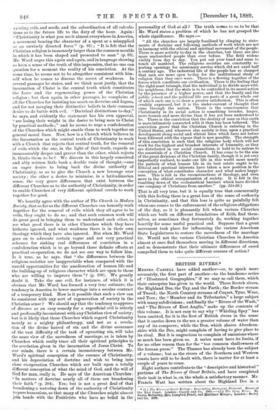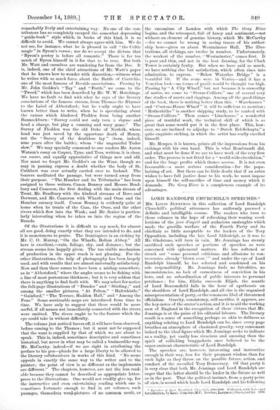BRITISH RIVERS.* MESSRS. CASSELL have added another—or, to speak more
accurately, the first part of another—to the handsome series of "Illustrated Geographies," if we may so call them, which their enterprise has given to the world. Three Scotch rivers, the Highland Dee, the Tay, and the Forth ; the Border stream of Tweed; the North Country streams of Coquet, Tyne, Wear, and Tees ; the " Humber and its Tributaries," a large subject with many subdivisions ; and finally the " Rivers of the Wash." and "The Rivers of East Anglia," make up the contents of this volume. It is not easy to say why " Whirling Spey" has been omitted, for it is the first of British rivers in the sense that it carries down to the sea a greater volume of water than any of its compeers; while the Don, which shares Aberdeen- shire with the Dee, might complain of having to give place to its rival. But it is ungracious to complain of omissions where so much has been given us. A series must have its limits, if for no other reason than for the " too common shallowness of the human purse." The Thames has already been the subject of a volume; but as the rivers of the Southern and Western coasts have still to be dealt with, there is matter for at least a couple of years to come.
Eight authors contribute to the " descriptive and historical " portions of The Rivers of Great Britain, and have completed their task in what is, on the whole, a satisfactory manner. Mr. Francis Watt has written about the Highland Dee in a • (1 ) The Ricers of Great Britain Descriptive, Historical, Pictorial. Rivers of the East Coast. London: Cassell and Co. 1889.—.(2.) The Gray River. By Justin McCarthy, Mrs, Campbell Praed, and Mortimer Menpes, London : Seeley and Co, 1 remarkably lively and entertaining way. No one of the con- tributors has so completely escaped the somewhat depressing " guide-book " style which, in books of this kind, it is so difficult to avoid. We cannot always agree with him. We do not see, for instance, what he is pleased to call " the Celtic magic" in Byron's verses ; nor do we accept the dictum that " Byron's poetry is before all romantic." There is far too much of Byron himself in it for that to be true. But both Mr. Watt and ourselves are wandering far from the Dee. It is, indeed, one of the chief attractions of Mr. Watt's paper that he knows how to wander with discretion,—witness what he writes with so much force about the Battle of Conichie, one of the most famous of Dceside associations. Passing by Mr. John Geddes's " Tay " and " Forth," we come to the "Tweed," which has been described by Mr. W. W. Hutchings. We have no fault to find with what he says of the literary associations of the famous stream, from Thomas the Rhymer to the Laird of Abbotsford ; but he r:,ally ought to have known better than to write, when he is speculating about the causes which hindered Flodden from being another Bannockburn : " Surrey could not only turn a rhyme and head a charge, but play a cunning and wary game." The Surrey of Flodden was the old Duke of Norfolk, whose head was just saved by the opportune death of Henry, not the " Surrey of the deathless lay " (born, indeed, nine years after the battle), whom " the ungrateful Tudor slew." We may specially commend to our readers Mr. Aaron Watson's essay on Coquet, Tyne, and Tees, written, it is clear, con amore, and equally appreciative of things new and old. Nor must we forget Mr. Geddes's on the Wear, though we may in passing express a doubt whether the body of. St. Cuthbert was ever actually carried over to Ireland. The bearers meditated the passage, but were turned away from their purpose. " The Humber and its Tributaries " has been assigned to three writers, Canon Bonney and Messrs. Brad- bury and Cameron, the first dealing with the main stream of Trent, Mr. Bradbury with the kindred streams of Dove and Derwent, and Mr. Cameron with Wharfe and Ouse and the Humber estuary itself. Canon Bonney is evidently quite at home when he treats of the Cam, the Ouse, and the other rivers which flow into the Wash; and Mr. Senior is particu- larly interesting when he takes us into the region of the Broads.
Of the illustrations it is difficult to say much, for almost all are good, doing exactly what they are intended to do, and it is monotonous to praise. The frontispiece is an etching by Mr. C. 0. Murray, " On the Wharfe, Bolton Abbey." All here is excellent,—ruin, foliage, sky, and distance ; but the stream seems less happily given. The too visible mechanism of production in the upper reach is not pleasing. For the other illustrations, the help of photography has been largely used, and with results that are almost universally satisfactory. Now and then there seems to have been a mishap somewhere, as in " Abbotsford," where the angler seems to be fishing with a line of most portentous thickness ; but it is very seldom that there is anything to find fault with. We may select for notice the full-page illustrations of " Dundee" and " Stirling ;" and among the smaller pictures, " At Felton," Haltwhistle," " Gainford," " The Terrace, Haddon Hall," and " Among the Fens." Some serviceable maps are introduced from time to time. We have only to suggest that these would be more useful, if all names not immediately connected with the rivers were omitted. The rivers ought to be the feature which the eye could take in without difficulty.
The volume just noticed leaves off, it will have been observed, before coming to the Thames ; but it must not be supposed that the want is supplied by that of which we are about to speak. This is, indeed, sometimes descriptive and sometimes historical, but never in what may be called a businesslike way. Mr. McCarthy, indeed—if we are right in attributing the preface to his pen—pleads for a large liberty to be allowed to the literary eollaborateurs in works of this kind. " No scene appeals in exactly the same way to the writer and to the painter; the point of view is as different as the implements are different." The chapters, however, are not the less read- able because they cannot be described as appropriate letter- press to the illustrations. One would not readily give up, for the instructive and even entertaining reading which one is sometimes fortunate enough to find in art volumes, such passages, themselves word-pictures of no common merit, as the encomium of London with which The Gray River begins, and the retrospect, full of fancy and sentiment,—not without an element of genuine history, which Mr. McCarthy —for we cannot be wrong in seeing traces of his author- ship here—gives us about Westminster Hall. The illus. trations,all etchings, are twelve in number. Unfortunately, the weakest of the number, " Westminster," comes first. It is poor and thin, and not in the best drawing, for the Clock Tower is certainly faulty. But when we have said so much, we have nothing else but satisfaction, which often rises into admiration, to express. " Below Waterloo Bridge " is a beautiful bit. If the scene were in Venice—and it has a Venetian look—no terms of prait;c would be thought too high. Passing by " A City Wharf," but not because it is unworthy of notice, we come to " Steam-Colliers," one of several very fine studies of masts and riggings. Among all the good things of the book, there is nothing better than this. " Warehouses " and " Custom-House Wharf " it will be sufficient to mention ; " Rotherhithe " is another shipping study, to be ranked with " Steam-Colliers." Then comes " Limehouse," a wonderful piece of truthful work, the technical skill of which is so great that some would put it in the first place. This, how- ever, we are inclined to adjudge to " Dutch Eel-Schuyts," a quite exquisite etching, in which the artist has really excelled himself.
Mr. Menpes, it is known, prints all the impressions from his etchings with his own hand. This is what Rembrandt did, and what must be done if we are to have work of the very first order. The process is not fitted for a " world-wide circulation," and for the huge profits which thence accrue. It is not even favourable—a more serious consideration—for the popu- larising of art. But there can be little doubt that if an artist wishes to have full justice done to his work, he must impose upon himself the self-sacrifice of time and money which it demands. The Gray River is a conspicuous example of its advantages.











































 Previous page
Previous page